![]()
Nepetalactone
The molecule in catnip that makes cats stoned.
![]()
Paul May
Bristol University, UK
![]()
Molecule of the Month - March 2017.
Also available: JSMol version.
![]()

Hey wow...the world is so...so... full of colours!
|
NepetalactoneThe molecule in catnip that makes cats stoned.
Paul May
Molecule of the Month - March 2017.
|
|
Well, they appear to, as the photos below show. They roll around on the ground, pawing the air, leap about, and then get drowsy. Their eyes and expressions also have a sort of blissful, dreamy appearance, which has been likened to those of druggies on a trip. More accurately they exhibit behaviour patterns common to females in heat, irrespective of whether the cat is male or female!
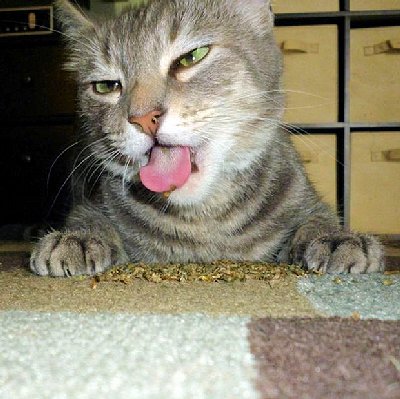 |
 |
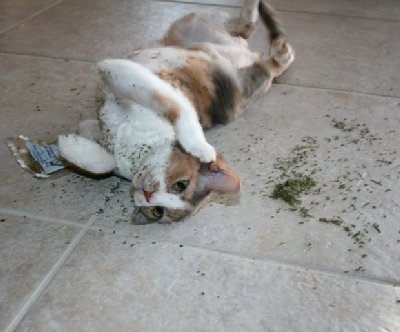 |
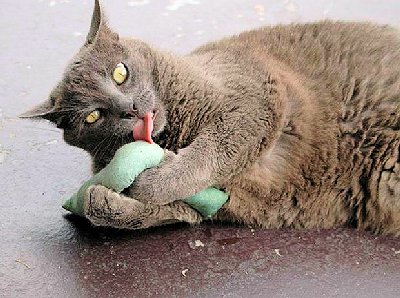 |
Well, catnip contains a mixture of chemicals, including nepetalactone, which appears to act biochemically very similarly to feline pheromones (sexual attractant molecules). Indeed, kittens are not affected, and they only begin to become affected when they reach sexual maturity. Nepetalactone in high doses (much higher than a cat would normally get from sniffing a female cat on heat) is thought to be slightly halucinogenic so exposure to it causes cats to experience a rush of euphoria. Unlike drugs which have a euphoric effect on humans (cocaine [MOTM February 2016], heroin [in MOTM November 2004], LSD [MOTM December 1998], etc.), it does not appear to be addictive or harmful in any way to the cats.
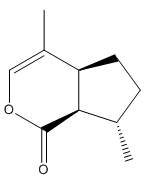 |
Nepetalactone |
No, human brains are physiologically very different from those of cats, so nepetalactone has no proven effect on us. However there are claims that it produces a relaxing effect when smoked, although not more so than other herbal cigarettes.
What about on other animals?Well, itís known to affect other members of the cat family, such as leopards, lynxes, cougars, lions and tigers, although because the behaviour is hereditary about a third of felines have no response at all. In fact one of the first papers to report the effects of nepetalactone described what happened when it was given to lions at a local zoo: "With the exception of the three cubs that were present, all of the lions responded immediately to nepetalactone in the same manner that they do to the oil of catnip and to the fresh plant, the latter of which is given to them regularly during the summer. The reaction of the lions to either nepetalactone or the catnip plant is quite similar to that of an ordinary house cat. They can be aroused immediately from a state of lethargy to one of intense excitement by the odor of the lactone, and will follow the odor to its source. When they acquire the material with the odor they become ludicrously playful and their main interest seems to be to get the odoriferous material transferred to their fur. They show no desire to eat the material, nor is there any evidence of sexual stimulation." S.M. McElvain et al, JACS 64 (1942) 1828. But there are no reports, as far as we know, of nepetalactone affecting other mammals, although it is known to be an effective mosquito and fly repellent. Indeed, one theory is that cats rub catnip all over their fur for precisely this reason - to prevent mosquito bites. Where does catnip originate from?Itís found in varieties of the catmint plant, and is released when the stems or leaves are damaged. This is why cats often jump up and down or roll in beds of catmint, to try to damage the plants to release the molecules. The original catmint plant is called Nepeta cataria, named after the ancient city of Nepeta in northern Italy, and Cataria being derived from the Latin for cat, but there are dozens of Nepeta varieties which have similar effects. |
|
The molecule actinidine, found in plants such as valerian (Valeriana officinalis) or silver vine (Actinidia polygama) also seems to be a cat attractant, as does iridomyrmecin, an ant defence chemical.
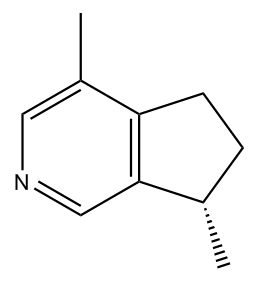 |
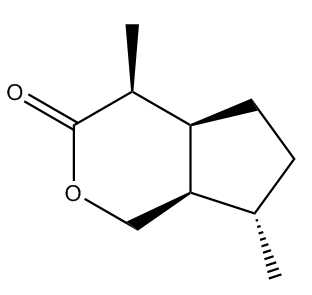 |
Actinidine |
Iridomyrmecin |
The common structure seems to be the Ďiridoidí, a bicyclic cis-fused cyclopentane-pyrans, i.e. a six-membered ring containing an O or N, directly bonded to a five-membered ring with a methyl side-chain. These are commonly produced by plants and some insects as defensive agents against predators as they taste very bitter. The link with cats seems purely coincidental.
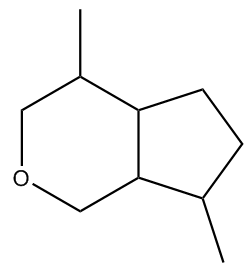
Iridoid-like structural component. The O can be replaced by N or C, and there are many variations
on this basic structure which work as cat attractants to greater or lesser degrees.
As well as the Nepeta catmint family of plants, it seems than many other mint plants (even peppermint flavoured chewing gum!) also have a similar but lesser effect on cats than catmint. Because other mint plants donít contain nepetalactone, some other molecule must be involved. Menthol is an obvious suspect, because there are numerous reports of cats having blissful highs or exhibiting euphoric behaviour after sniffing minty household product which contain menthol, such as Vickís VapoRub, Tiger Balm or Bengay analgesic heat rub.
 |
 |
 |
| Vicks Vaporub | Tiger Balm | Bengay |
But surprisingly there seem to have been no scientific tests to prove this yet. Structurally, menthol is passably similar to the iridoid skeleton, but different in that itís missing the O or N in the ring, and is absent the 5-membered ring altogether. However it is not advised to let a cat lick these products, no matter how much they seem to want to, as the formulation often contain other ingredients, such as camphor and salicylates (similar to aspirin) that are toxic to cats.
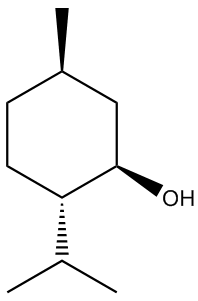 |
Menthol |

"Hey manÖ.I just canít get enough of this great weedÖ"
![]()
![]()
![]() Back to Molecule of the Month page. [DOI:10.6084/m9.figshare.5259997]
Back to Molecule of the Month page. [DOI:10.6084/m9.figshare.5259997]